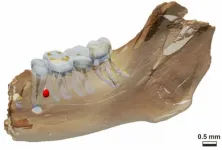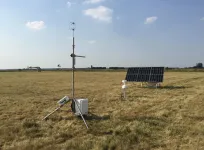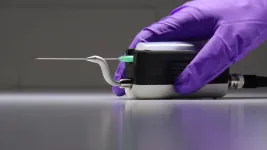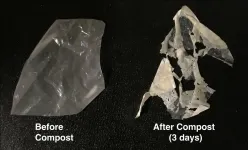Bistable pop-up structures inspired by origami
Next-generation inflatable buildings maintain their shape without constant input of pressure
2021-04-21
(Press-News.org) In 2016, an inflatable arch wreaked havoc at the Tour de France bicycle race when it deflated and collapsed on a cyclist, throwing him from his bike and delaying the race while officials scrambled to clear the debris from the road. Officials blamed a passing spectator's wayward belt buckle for the arch's collapse, but the real culprit was physics.
Today's inflatable structures, used for everything from field hospitals to sporting complexes, are monostable, meaning they need a constant input of pressure in order to maintain their inflated state. Lose that pressure and the structure returns to its only stable form -- flat.
But what if these structures had more than one stable state? What if the arch was just as stable inflated as it is flat on the ground?
Now, researchers at the Harvard John A. Paulson School of Engineering and Applied Sciences (SEAS) have developed bistable inflatable structures inspired by origami.
The research is published in Nature.
"This research provides a direct pathway for a new generation of robust, large-scale inflatable systems that lock in place after deployment and don't require continuous pressure," said Katia Bertoldi, the William and Ami Kuan Danoff Professor of Applied Mechanics at SEAS and senior author of the paper.
Inspired by origami and guided by geometry, the research team developed a library of triangular building blocks that can pop up or fold flat and be combined in different configurations to build closed, multistable shapes.
"We are relying on the geometry of these building blocks, not the material characteristics, which means we can make these building blocks out of almost any materials, including inexpensive recyclable materials," said Benjamin Gorissen, an associate in Materials Science and Mechanical Engineering at SEAS and co-first author of the paper.
Taking their design process to the real world, the researchers designed and built an 8 foot by4 foot inflatable shelter out of thick plastic sheets.
"You can imagine these shelters being deployed as part of the emergency response in disaster zone," said David Melancon, a PhD student at SEAS and co-first author of the paper. "They can be stacked flat on a truck and you only need one pressure source to inflate them. Once they are inflated, you can remove the pressure source and move onto the next tent."
The shelter can be set up by one or two people, as opposed to the dozen or so it takes to deploy today's military field hospitals.
The building blocks of these origami structures can be mixed and matched to create a structure of any shape or size. The researchers built a range of other structures, including an archway, an extendable boom and a pagoda-style structure. The researchers also designed shapes with more than two stable forms.
"We've unlocked an unprecedented design space of large-scale inflatable structures that can fold flat and maintain their deployed shape without the risk of catastrophic rupture," said Chuck Hoberman, the Pierce Anderson Lecturer in Design Engineering at the Graduate School of Design and co-author of the paper. "By using inflatable, reversible actuation to achieve hard-walled structural enclosures, we see important applications, not only here on Earth, but potentially as habitats for lunar or Mars exploration."
INFORMATION:
This research was co-authored by Carlos J. García-Mora. It was supported by the National Science Foundation under grants DMR-2011754 and DMR- 407 1922321.
[Attachments] See images for this press release:
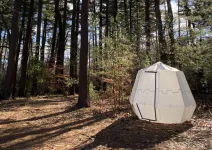
ELSE PRESS RELEASES FROM THIS DATE:
2021-04-21
What is the cost of 1 ton of a greenhouse gas? When a climate-warming gas such as carbon dioxide or methane is emitted into the atmosphere, its impacts may be felt years and even decades into the future - in the form of rising sea levels, changes in agricultural productivity, or more extreme weather events, such as droughts, floods, and heat waves. Those impacts are quantified in a metric called the "social cost of carbon," considered a vital tool for making sound and efficient climate policies.
Now a new study by a team including researchers from Lawrence Berkeley National Laboratory (Berkeley Lab) ...
2021-04-21
Despite our efforts to sort and recycle, less than 9% of plastic gets recycled in the U.S., and most ends up in landfill or the environment.
Biodegradable plastic bags and containers could help, but if they're not properly sorted, they can contaminate otherwise recyclable #1 and #2 plastics. What's worse, most biodegradable plastics take months to break down, and when they finally do, they form microplastics - tiny bits of plastic that can end up in our oceans, fish, and even our bodies.
Now, as reported in the journal Nature, scientists at the Department ...
2021-04-21
A study that appeared today on Current Biology sheds new light on the continental migrations which shaped the genetic background of all present Europeans. The research generates new ancient DNA evidence and direct dating from a fragmentary fossil mandible belonging to an individual who lived ~17,000 years ago in northeastern Italy (Riparo Tagliente, Verona). The results backdate by about 3,000 years the diffusion in Southern Europe of a genetic component linked to Eastern Europe/Western Asia previously believed to have spread westwards during later major warming shifts.
"By looking into the past of this particular individual, ...
2021-04-21
Astronomers using data from NASA and the ESA (European Space Agency) telescopes have released a new all-sky map of the outermost region of our galaxy. Known as the galactic halo, this area lies outside the swirling spiral arms that form the Milky Way's recognizable central disk and is sparsely populated with stars. Though the halo may appear mostly empty, it is also predicted to contain a massive reservoir of dark matter, a mysterious and invisible substance thought to make up the bulk of all the mass in the universe.
The data for the new map comes from ESA's Gaia mission and NASA's Near Earth Object Wide Field Infrared Survey Explorer, or NEOWISE, which operated from 2009 to 2013 under the moniker WISE. The study, led by astronomers at the Center for ...
2021-04-21
Substantial cuts in global greenhouse gas emissions could be achieved by raising water levels in agricultural peatlands, according to a new study in the journal Nature.
Peatlands occupy just three per cent of the world's land surface area but store a similar amount of carbon to all terrestrial vegetation, as well as supporting unique biodiversity.
In their natural state, they can mitigate climate change by continuously removing CO2 from the atmosphere and storing it securely under waterlogged conditions for thousands of years.
But many peatland areas have been substantially modified by human activity, including drainage for agriculture and forest plantations. This results in the ...
2021-04-21
Scientists have found fragments of titanium blasting out of a famous supernova. This discovery, made with NASA's Chandra X-ray Observatory, could be a major step in pinpointing exactly how some giant stars explode.
This work is based on Chandra observations of the remains of a supernova called Cassiopeia A (Cas A), located in our galaxy about 11,000 light-years from Earth. This is one of the youngest known supernova remnants, with an age of about 350 years.
For years, scientists have struggled to understand how massive stars - those with masses over about 10 times that of the Sun - explode when they run ...
2021-04-21
The diagnosis of diseases like cancer almost always needs a biopsy - a procedure where a clinician removes a piece of suspect tissue from the body to examine it, typically under a microscope. Many areas of diagnostic medicine, especially cancer management, have seen huge advances in technology, with genetic sequencing, molecular biology and artificial intelligence all rapidly increasing doctors' ability to work out what's wrong with a patient. However the technology of medical needles hasn't changed dramatically in 150 years, and - in the context of cancer management - needles are struggling to provide adequate tissue samples for new diagnostic techniques. Now researchers have shown that modifying the biopsy needle to vibrate rapidly ...
2021-04-21
PHILADELPHIA--Piperlongumine, a chemical compound found in the Indian Long Pepper plant (Piper longum), is known to kill cancerous cells in many tumor types, including brain tumors. Now an international team including researchers from the Perelman School of Medicine at the University of Pennsylvania has illuminated one way in which the piperlongumine works in animal models -- and has confirmed its strong activity against glioblastoma, one of the least treatable types of brain cancer.
The researchers, whose findings were published this month in END ...
2021-04-21
Scientists have spotted the largest flare ever recorded from the sun's nearest neighbor, the star Proxima Centauri.
The research, which appears today in The Astrophysical Journal Letters, was led by the University of Colorado Boulder and could help to shape the hunt for life beyond Earth's solar system.
CU Boulder astrophysicist Meredith MacGregor explained that Proxima Centauri is a small but mighty star. It sits just four light-years or more than 20 trillion miles from our own sun and hosts at least two planets, one of which may look something like ...
2021-04-21
RESEARCH TRIANGLE PARK, N.C. -- With Army funding, scientists invented a way to make compostable plastics break down within a few weeks with just heat and water. This advance will potentially solve waste management challenges at forward operating bases and offer additional technological advances for American Soldiers.
The new process, developed by researchers at University of California, Berkeley and the University of Massachusetts Amherst, involves embedding polyester-eating enzymes in the plastic as it's made.
When exposed to heat and water, an enzyme shrugs off its polymer shroud and starts chomping the plastic polymer into its building blocks -- in the case of biodegradable plastics, which are made primarily of the polyester known as polylactic acid, or PLA, ...
LAST 30 PRESS RELEASES:
[Press-News.org] Bistable pop-up structures inspired by origami
Next-generation inflatable buildings maintain their shape without constant input of pressure


